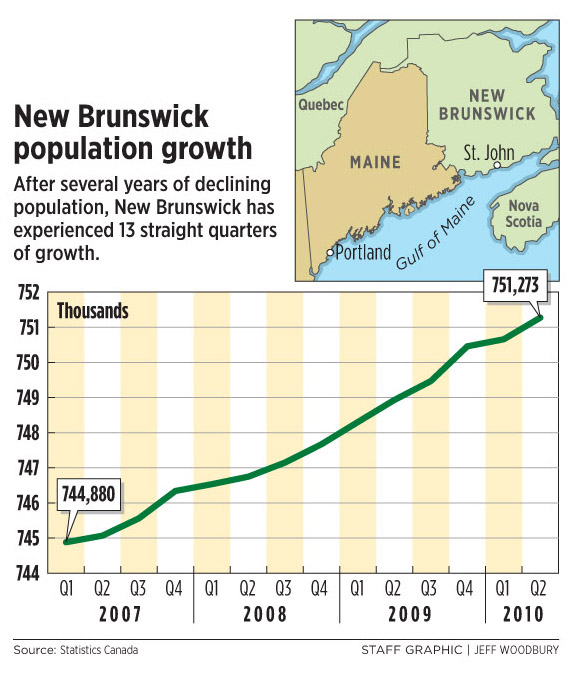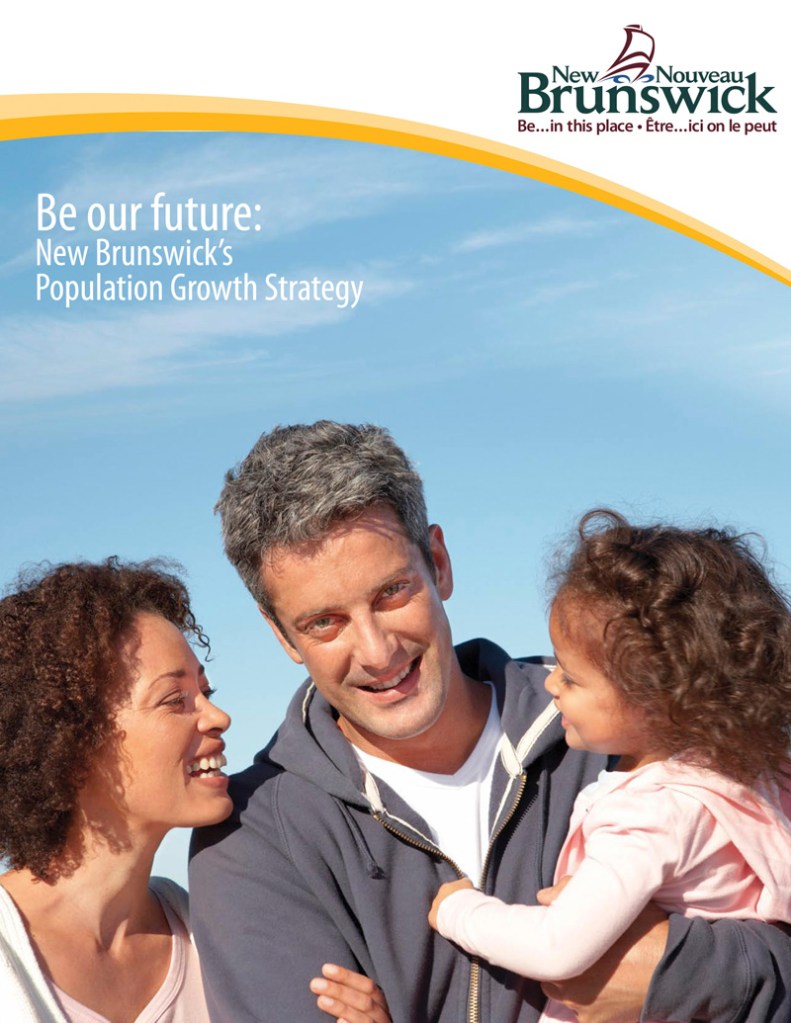SAINT JOHN, NEW BRUNSWICK – This Maritime province shares many traits with its western neighbor, Maine.
Both places are defined by their forests and rugged coastlines. Both value independence and self-reliance. And in both places, the vast majority of residents are white and aging.
As the baby boom generation begins to retire, officials and business leaders in both New Brunswick and Maine have fretted over where the next wave of workers, homeowners and taxpayers will come from. Unlike Maine, New Brunswick is taking strong action.
New Brunswick has developed a multipart strategy to grow its population, and it appears to be working.
After a period of decline, the number of people moving to the province is exceeding the number leaving. The population now numbers roughly 750,000 and has grown every quarter during the past three years. The province has added nearly 6,400 residents since the start of 2007, according to Statistics Canada.
One way New Brunswick has done this is to target foreign workers who have specific training and entice them to immigrate here. It helps them upgrade language skills, and plug in to housing and employment opportunities, at four “newcomer welcome centers” around the province. The centers are paid for by the government, but run by local multicultural groups. One opened last May in Saint John, the province’s largest city and business hub, roughly an hour’s drive from the Maine border at Calais.
“Where’s the tax base going to be in 15 years, if we don’t welcome new people?” asked Nathan White, the community outreach officer at the Saint John Multicultural & Newcomers Resource Centre.
That question could be asked in Maine.
Maine is the oldest and whitest state in the United States. The median age is 44. Ninety six percent of residents are white. Moreover, Maine’s overall growth rate has slowed since the 1980s to half the U.S. rate, with further declines expected.
Population growth, or the lack of it, has been a worry for years in New Brunswick.
In 2006, the newly elected Liberal government of Premier Shawn Graham created an agency to attract and retain residents, the Population Growth Secretariat. It released a growth strategy called Be Our Future. The plan focuses on increasing and targeting immigration, keeping young people in the province and luring former New Brunswickers back home. The government earmarks $5 million a year for the effort, up from $1.6 million in the previous administration.
“We were really struggling with people leaving, especially in the north,” said Brendan Langille, a spokesman for the Population Growth Secretariat.
Young people were heading west, many to Toronto and Ottawa. The oil and gas boom led others to Alberta.
At the same time, though, New Brunswick was creating jobs, notably in information technology, health care and energy. Employment in the province has grown by 10,500 jobs since 2006, according to Statistics Canada. A missing link, Langille said, was the education and retraining needed to fill those jobs.
One strategy to entice people to move or stay here is to help pay for their education. New Brunswick does that through a tuition rebate program. Residents who graduate from an eligible post-secondary school and work here can get a tax rebate of half their tuition costs, up to a maximum of $20,000.
To attract workers for industries that need skilled labor, the government staffs a “repatriation team.” The team conducts missions to major Canadian cities. It also goes to New York and Boston. Provincial companies join the missions, looking to fill key positions.
“They come with us,” Langille said. “We bring their human resource people with us and they hire people on the spot.”
These missions have been helpful to companies such as Mariner Partners Inc., a growing Saint John firm that develops technology solutions for television over the Internet. Mariner has 123 employees, but has had to look outside the province for senior developers and analysts with specific experience, said Marie Jo Thibault, the company’s marketing and communications director.
Thibault went on two missions, to an information technology show in Toronto and a business fair in Montreal. Mariner set up a booth inside the Population Growth Secretariat’s pavilion with more than a dozen other companies and regional economic development groups. Most of the people who check out New Brunswick’s pavilion are already planning to change jobs or move, she said.
“You can find the gems by talking to them and looking at their resumes,” she said.
Courting people from other provinces and the United States helps, but it’s not driving provincial growth. The leading contributor is immigration.
With its low birthrate and small population, Canada has a national policy aimed at attracting entrepreneurs and skilled workers. New Brunswick has built on this policy in the past decade by signing an agreement with the federal government that lets the province speed visa applications for foreigners with specific skills who want to come here and start a business.
The greatest number of immigrants have come from South Korea, followed by China. In the best case, they are young people who start families.
Deepa Paga came to Saint John after her husband, who was working for an information technology subcontractor in their native India, received a work permit in 2007 from J.D. Irving Ltd., a subsidiary of New Brunswick’s largest employer. Irving supported the husband’s emigration because his skills were needed. The couple now has permanent residency, and a 2-year-old daughter.
Paga was hired to help with research at the newcomer center. She has applied to attend community college in the fall, with the goal of becoming a programmer analyst.
“The best part of living in Saint John,” she said, “is it’s a very quiet and small place, the people are helpful and they speak English.”
Paga’s situation isn’t unusual at the Saint John center, which aided 500 clients in its first year.
“A lot of them are bringing their life savings and starting a business,” said White, the outreach coordinator.
The local business community has begun to tap the center as a resource to help meet labor needs. It’s a slow process of building awareness and acceptance, White said.
“People are pretty welcoming here, but they need to get used to a multicultural society,” he said.
Some businesses that need workers to grow have reached that conclusion.
St. Stephen is the commerce center of Charlotte County, across the St. Croix River from Calais, Maine. Chocolate maker Ganong Bros. Ltd. needed 50 workers to handle a big contract. Unable to fill the jobs with local residents, Ganong hired 30 workers from Romania, which has high unemployment and a climate and religious background similar to New Brunswick.
Ganong made extra efforts to make the Romanians welcome, according to media reports. It found furnished apartments and even filled the refrigerators with food. All of the workers have since applied for permanent resident status.
Most of these strategies would be unnecessary if New Brunswick could keep more of its young people from leaving. That’s a familiar lament in Maine and most rural places, where an exodus to bright lights and wider opportunities is almost a rite of passage.
“But people aren’t leaving here just to see the world,” Langille said. “There’s a perception that jobs and opportunity don’t exist here, and that’s the perception we’re trying to combat.”
New Brunswick funds various “youth engagement” programs. It reaches out on social networking sites and it tries to drive participants to a job search website subsidized by the province.
“We realize that if we could keep more young people here, we wouldn’t need to worry about anything else,” Langille said.
Staff Writer Tux Turkel can be contacted at 791-6462 or at:
tturkel@pressherald.com
Send questions/comments to the editors.





Success. Please wait for the page to reload. If the page does not reload within 5 seconds, please refresh the page.
Enter your email and password to access comments.
Hi, to comment on stories you must . This profile is in addition to your subscription and website login.
Already have a commenting profile? .
Invalid username/password.
Please check your email to confirm and complete your registration.
Only subscribers are eligible to post comments. Please subscribe or login first for digital access. Here’s why.
Use the form below to reset your password. When you've submitted your account email, we will send an email with a reset code.